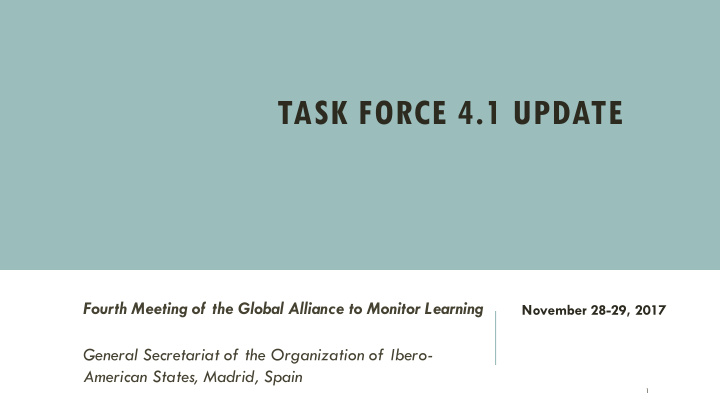



TASK FORCE 4.1 UPDATE Fourth Meeting of the Global Alliance to Monitor Learning November 28-29, 2017 General Secretariat of the Organization of Ibero- American States, Madrid, Spain 1
OVERVIEW 1. Task Force 4.1 composition and mandate 2. Progress to date 3. Inputs to 4.1.1 measurement and reporting strategy 4. Conclusions and next steps 2
1. TASK FORCE 4.1 COMPOSITION & MANDATE 61 volunteers representing various stakeholders, countries, and organizations Identify technical approaches to measurement of learning under Target 4.1, particularly Indicator 4.1.1. Target 4.1 : By 2030, ensure all Indicator 4.1.1 : Proportion: (a) in grades 2/3; complete quality primary and (b) at end of primary; and (c) end of lower secondary education leading to secondary achieving at least minimum relevant learning outcomes proficiency in (i) reading, (ii) math, by sex 3
2. PROGRESS TO DATE 5 meetings – March 8; April 3, 10; August 17, October 10 3 GAML technical products/outputs reviewed 2 Learning Progression Explorer Webinars 2 cross-national assessments expert meetings 1 Subgroup on 4.1.1a Report: “ Task Force 4.1 Inputs to the Measurement and Reporting Strategy for Indicator 4.1.1” 4
3. INPUTS TO 4.1.1 MEASUREMENT & REPORTING STRATEGY Overall recommendations for next steps GAML Secretariat/UIS to convene diverse group of content experts, developmental psychologists, assessment experts, and others who can bring latest research, evidence, and data to bear on drafting of longer-term strategy, particularly for 4.1.1a. Countries to be more actively brought into discussions on 4.1.1 to ensure that proposed measurement and reporting approaches are sufficiently adaptive and responsive to their contexts. 5
3. INPUTS TO 4.1.1 MEASUREMENT & REPORTING STRATEGY ctd Recommendations for 3 phases I. Conceptual framework: Who and what to assess? II. Methodological framework: How to assess? III. Reporting framework: How to report? 6
I. Conceptual framework: Who and what to assess? • Most assessment programs provide grade-based data relevant to 4.1.1b Status and 4.1.1c • 4.1.1a assessments should focus on precursor and early skills; emphasize Key Issues accuracy, comprehension, automaticity/speed. Very few cross-national assessments measure these precursor and early skills. • Short-term: (i) Continue with mapping frameworks, but more focus on Recommendations grades 2/3; (ii) Consider drawing on EGRA, EGMA, household/citizen tools for 4.1.1a • Longer-term: Develop set of purpose-built tools for countries for 4.1.1a 7
Task Force feedback on content reference frameworks for mapping Extend/test against other languages and cultures Incorporate other disciplines/perspectives Use more explicitly research-based approach and more specialist input Incorporate more concrete examples Explain how framework might be adapted over time 8
II. Methodological framework: How to assess? Status • Most assessments emphasize sample-based and group-administered approaches and primarily focus on children and youth in school. • Most early-years assessments designed for one-on-one administration Key Issues • How (i) include OOSC, (ii) determine acceptable minimum data quality requirements, (iii) decide which assessment to use? • Short-term: Be flexible and focus more on encouraging countries to get in habit of submitting data on learning Recommendations • Longer-term: Move towards more school-based and group- administered approaches and more rigorous standards and criteria 9
III. Reporting framework: How to report? • Most cross-national assessments convert raw to scaled scores using IRT Status and report scaled scores and % of students reaching specific proficiency levels • Many national assessments still report mean raw scores or % correct. Key Issues • Comparability of results across systems and languages is issue for all assessments. • Short-term: (i) Prioritize comparisons within languages. (ii) Use hybrid Recommendations approach of translation and adaptation to balance relative difficulty of instruments across languages and enhance comparability • Longer-term: Enhance comparability of results by linking assessments 10
Task force feedback on UIS reporting scale Clarify relationship to Content Reference Frameworks Be clearer about objective and target audience Pay more attention to representation, inclusion, efficiency in empirical validation Consider using more traditional reporting scale Consider developing three scales, one for each measurement point Consider giving more attention to development of existing cross- national assessments 11
Task Force feedback on setting benchmarks on reporting scale 1. Global or national “minimum proficiency” benchmarks? Even split 2. One or three “minimum proficiency” benchmarks per domain? Majority in favor of 3 benchmarks 3. Existing “minimum proficiency” benchmarks or new benchmarks? Slightly more in favor of existing 4. Global or national expectations for % of students to reach “minimum proficiency”? Even split 5. Status- or progress-based expectations? Slightly more in favor of status-based 12
4. CONCLUSIONS & NEXT STEPS Short-term Longer-term Continue mapping assessment frameworks, but with more focus on grades 2/3 Consider drawing on EGRA, EGMA, Develop set of purpose-built tools for 4.1.1a household/citizen tools for 4.1.1a Be flexible, focus on encouraging countries to Move towards more school-based and group- get in habit of submitting data administered approaches and more rigorous technical standards and criteria Prioritize comparisons within languages. Use Enhance comparability of results through hybrid approach of translation and linking assessments adaptation to balance relative difficulty of instruments. 13
4. CONCLUSIONS & NEXT STEPS • Content reference frameworks • UIS Reporting Scale and Benchmarks Extend/test against other languages Clarify relationship to Content Frameworks and cultures Be clear about objective and audience Use more explicitly research-based Pay attention to representation, inclusion, approach, more specialist input, efficiency in empirical validation other disciplines Consider using more traditional reporting Incorporate more concrete scale examples Develop 3 scales, one per measurement Explain how framework might be point adapted over time Use 3 benchmarks per domain, one for each measurement point Give more attention to development of existing cross-national assessments 14
Recommend
More recommend